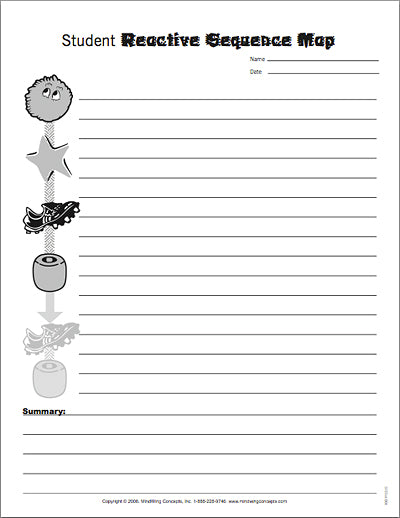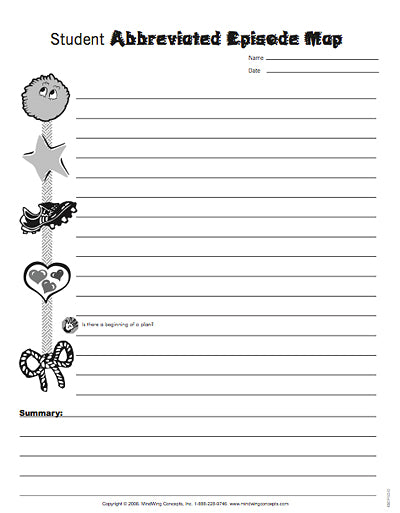Happy Holidays! 15% OFF and FREE SHIPPING all ONLINE purchases over $60!
***Use Code: HOLIDAYS2024 at checkout***
(free shipping valid only within continental U.S.)
Menu
-
- Home
-
About Us
-
The Approach
-
Linking Language & Literacy
-
MindWing Learning
-
Learning Resources
-
SHOP
-
Blog
-
- About MindWing
- Our People
- Contact Us
- Your Account
- Login
-
United States (USD $)

Happy Holidays! 15% OFF and FREE SHIPPING all ONLINE purchases over $60!
***Use Code: HOLIDAYS2024 at checkout***
(free shipping valid only within continental U.S.)
Simple Comics for More Advanced Language
by Sean Sweeney January 20, 2012 2 min read
At the elementary school level, we all can attest to seeing students who, narratively, get stuck at what we might call the “andthenandthenandthen” stage. The official name for this stage is the Action Sequence, and it is comprised of Characters, Settings, and a series of Actions with little variation in conjunction use. These students benefit from structures and contexts to move them into using to more complex story elements and cohesive ties such as when, because, and so. MindWing’s narrative maps, particularly the Reactive Sequence and Abbreviated Episode Maps, can provide that structure: (*Maps can be found in the Story Grammar Marker® Teachers’ Manual and the Talk to Write, Write to Learn™ Teachers’ Manual )

To construct a story where a character is in a particular setting when a kick-off occurs, so he/she reacts in a certain way.

To construct a story in which a character is in a particular setting when a kickoff occurs, so he/she has a feeling about it and makes a particular plan, resulting in a conclusion.
While these maps provide a structure, instructionally we also need a context. Comics are one way to provide that! Kids love comics, and narratively they tend to be shorter and work according to these structures. You can of course easily draw 4-panel comics, but there are a couple of great technology resources that you can employ to scaffold students to the next narrative level.
First up, MakeBeliefsComix (yes, I spelled that right) is a great simple web app you can use to make comics. This Flash-based (therefore, non-functional on iPad) website allows you to drag and drop characters, backgrounds, props and word/thought balloons into a scene. I recently used this site in a classroom to develop narrative as well as the social thinking™ skill of “defeating GlassMan ® moments.” From Think Social Publishing, this concept relates to using self-talk and other strategies to regulate our responses to small problems across the day. Kids in the class received instruction on narrative structure and thinking strategies, and were asked to make a comic showing a character experiencing (or defeating) a GlassMan moment, basically a Reactive Sequence or Abbreviated Episode:

MindWing’s Universal Magnets used to show what can happen in each panel, along with strategies the students could show the character using in a Plan to “defeat” a problem.
The super-simple MakeBeliefsComix site allows you to “Select emotions, objects, scenes, balloons and panel prompts to tell the story.” The resulting cartoon can be saved by emailing it to an established email account:


One students’ creation depicts Abraham Lincoln dealing with the kickoff of losing his bird companion by using self-talk!
This lesson could also be accomplished using the new iPad app Big Nate: Comix by U! HD ($4.99, separate version for iPhone is priced at $3.99), based on the popular book series. Like many iPad apps, this one opens with a great tutorial and works similarly to MakeBeliefComix, allowing you to tap and drag all the necessary elements of a fun story!


Sean Sweeney
Sean Sweeney, MS, MEd, CCC-SLP, is a speech-language pathologist and technology specialist working in private practice at the Ely Center in Needham, MA, and as a clinical supervisor at Boston University. He consults with local and national organizations on technology integration in speech and language interventions. His blog, SpeechTechie (www.speechtechie.com), looks at technology “through a language lens.” Contact him at sean@speechtechie.com.
Leave a comment
Comments will be approved before showing up.
